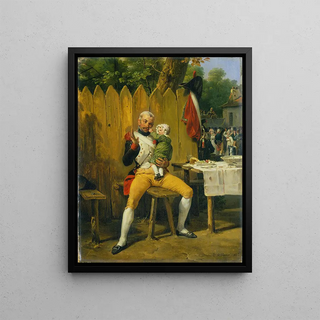Art print | The Veteran at Home - Horace Vernet


View from behind

Frame (optional)
Reproduction The Veteran at Home - Horace Vernet – Captivating Introduction
In the vibrant universe of art, some works transcend their era to become timeless witnesses to humanity. "The Veteran at Home" by Horace Vernet is one of these creations that, through the lens of war and peace, invites us to reflect on the human condition. This painting, imbued with emotion, depicts a touching reunion moment between a former soldier and his family. The veteran's gaze, both nostalgic and proud, immerses us in a visual narrative rich in feelings. The scene, loaded with symbolism, evokes not only the return home but also the indelible scars left by conflicts. Through this work, Vernet manages to capture the very essence of the human experience, making his painting universal and timeless.
Style and uniqueness of the work
Vernet's style is distinguished by a remarkable mastery of colors and lights, which give his works a depth and emotional intensity rarely seen. In "The Veteran at Home," the contrast between warm tones and delicate shadows creates an intimate atmosphere, almost tangible. Every detail, from the veteran's marked face to the expressions of his family members, is carefully crafted, demonstrating meticulous attention to human detail. The composition of the scene, where the characters are arranged to guide the viewer's gaze, reinforces the idea of storytelling, as if each element of the canvas narrates part of the story. Vernet, through his realistic approach, succeeds in establishing a strong emotional connection between the work and the viewer, inviting reflection on themes of war, sacrifice, and reconciliation.
The artist and his influence
Horace Vernet, son of the famous painter Carle Vernet, established himself as a major figure of French Romanticism. His career, marked by a passion for military scenes and portraits, allowed him to capture the very essence of his time. Vernet not only documented the events of his era but also influenced many artists through his unique way of representing human drama.

Matte finish

View from behind

Frame (optional)
Reproduction The Veteran at Home - Horace Vernet – Captivating Introduction
In the vibrant universe of art, some works transcend their era to become timeless witnesses to humanity. "The Veteran at Home" by Horace Vernet is one of these creations that, through the lens of war and peace, invites us to reflect on the human condition. This painting, imbued with emotion, depicts a touching reunion moment between a former soldier and his family. The veteran's gaze, both nostalgic and proud, immerses us in a visual narrative rich in feelings. The scene, loaded with symbolism, evokes not only the return home but also the indelible scars left by conflicts. Through this work, Vernet manages to capture the very essence of the human experience, making his painting universal and timeless.
Style and uniqueness of the work
Vernet's style is distinguished by a remarkable mastery of colors and lights, which give his works a depth and emotional intensity rarely seen. In "The Veteran at Home," the contrast between warm tones and delicate shadows creates an intimate atmosphere, almost tangible. Every detail, from the veteran's marked face to the expressions of his family members, is carefully crafted, demonstrating meticulous attention to human detail. The composition of the scene, where the characters are arranged to guide the viewer's gaze, reinforces the idea of storytelling, as if each element of the canvas narrates part of the story. Vernet, through his realistic approach, succeeds in establishing a strong emotional connection between the work and the viewer, inviting reflection on themes of war, sacrifice, and reconciliation.
The artist and his influence
Horace Vernet, son of the famous painter Carle Vernet, established himself as a major figure of French Romanticism. His career, marked by a passion for military scenes and portraits, allowed him to capture the very essence of his time. Vernet not only documented the events of his era but also influenced many artists through his unique way of representing human drama.






